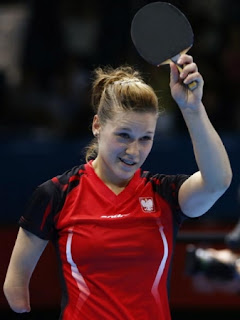The official table tennis rules say:
Service shall start with the ball resting freely on the open palm of the server's stationary free hand.They also say:
The server shall then project the ball near vertically upwards, without imparting spin, so that it rises at least 16cm after leaving the palm of the free hand and then falls without touching anything before being struck.
From the start of service until it is struck, the ball shall be above the level of the playing surface and behind the server's end line, and it shall not be hidden from the receiver by the server or his or her doubles partner or by anything they wear or carry.During this year's Olympics, several players have lost points due to these rules - for example Danish player Michael Maze, Chinese Ding Ning and Wang Hao, also from China. Which of the rules above that the umpire has referred to, hasn't been very clear, though.
Problem 1: Some rules aren't written very clearly. If you're supposed to throw the ball "near vertically upwards" - where do you draw the line? As a player you can't guarantee that the ball will rise/fall with an angle of 0, or 5, or 10 degrees. You just throw it in a way that fits your style.
Problem 2: The two umpires on the floor sits on each side of the table. They don't see the game the same way as the players do. They can't make an absolutely accurate appreciation of what the service receiver sees or not. Players often(!) throws the ball near their body so they hide it with their arm right before racquet impact - but do the umpires say anything? No. Almost never.
Problem 3: The umpires are people and not machines - they use their own opinions, which can differ and change - and even be absurd. All three players that have been mentioned above, have used the same technique in many services, but suddenly the umpires say that they're doing it wrong. Why don't they observe it the first time then? A point that is lost because of these rulings, throws the player's off, they lose their focus and changes their mood and therefore also their performance. If their methods aren't allowed by the rules, they should be told this as soon as possible. Not in an important semi-final where the mood plays a large roll.
On farm auctions, the auctioneer can sometimes start off the event by ignoring bidders and sell quickly - only to make people wake up. Break the rules to force people to follow them. I can partly understand if this is what's going on, but I can't see how something like that would work at all. And when a player does the same thing 20 times in a row and then gets a ruling against him - then something is seriously wrong.
Natalia Partyka from Poland, was born without most of her right forearm. Still, she's one of the best female players in the world. Therefore, she's competing in both the Paralympics for disabled people, and in the normal Olympics. Just that, makes me wonder. If she's so good that she can compete with the best normally abled players in the whole world - should she be allowed in the Paralympics...? I've seen 80 year old people with walking frames compete there. People in wheelchairs. People without arms. And this incredibly gifted girl is gonna go there and run them over like a bulldozer? Yeah, that seems fair.
And now we get back to rules and interpreting again. And have in mind that the condition that she has to accept to compete in the Olympics, is that she has to accept the normal rules.
"Service shall start with the ball resting freely on the open palm of the server's stationary free hand." She doesn't have any free hand. And she's not allowed to rest the ball on the racquet like in the Paralympics. Instead, she has been allowed to rest the ball on the little she has of her right forearm. It isn't even "resting freely", because it's supported by the bottom of her upper arm. And when watching slow-motion replays of her services, you can clearly see that the ball often isn't thrown up near 16 cm before falling. How many times have the umpires given her points away - or even warned her? Zero.
The question is: Where does she belong? Personally, I think she should be judged after her abilities - but it would be interesting to know how she got to bypass direct rules.
 |
| Natalia Partyka - Competes in the Olympics despite handicap |
No comments:
Post a Comment